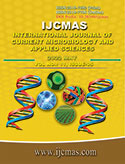


 National Academy of Agricultural Sciences (NAAS)
National Academy of Agricultural Sciences (NAAS)

|
PRINT ISSN : 2319-7692
Online ISSN : 2319-7706 Issues : 12 per year Publisher : Excellent Publishers Email : editorijcmas@gmail.com / submit@ijcmas.com Editor-in-chief: Dr.M.Prakash Index Copernicus ICV 2018: 95.39 NAAS RATING 2020: 5.38 |
The aim of the present study was to establish the age of productive life and milk yields of different lactations in Holstein cows, born in the period from 2010 to 2017 using the Test day approach. The object of the study are cows of the Holstein dairy breed, bred on 18 farms in different regions of the country. An analysis of 333,721 records of milk productivity data for the control day was performed for 22,464 animals born in the period 2010-2017. The data for the records of origin and productivity are provided by ARCHSHPB - Dobrich. To analyze the factors influencing the assessed traits - milk yield for the control day, fat and protein content, a mathematical model was formulated based on the following hypothesis: variation in milk yield and quality of milk for the control day is caused by genetic and environmental factors - individual, consecutive lactation, farm, breeder, month of production, effect of the genetic value of the individual and random, not studied and described in the model, factors. A control day model was used in which each daily milk control was considered as a separate observation. The data processing was performed using the software products Pest (Groeneveld) and SYSTAT 13. The number of animals that attained 4th and subsequent lactation was low. The influence of the environmental factor farm on the three studied traits was very significant. The sire, test-day month and parity has statistically significant influence on milk yields. The highest average daily milk yield in cows was observed during the third lactation. Neither milk fat nor milk protein contents demonstrated consistent variations.
 |
 |
 |
 |
 |